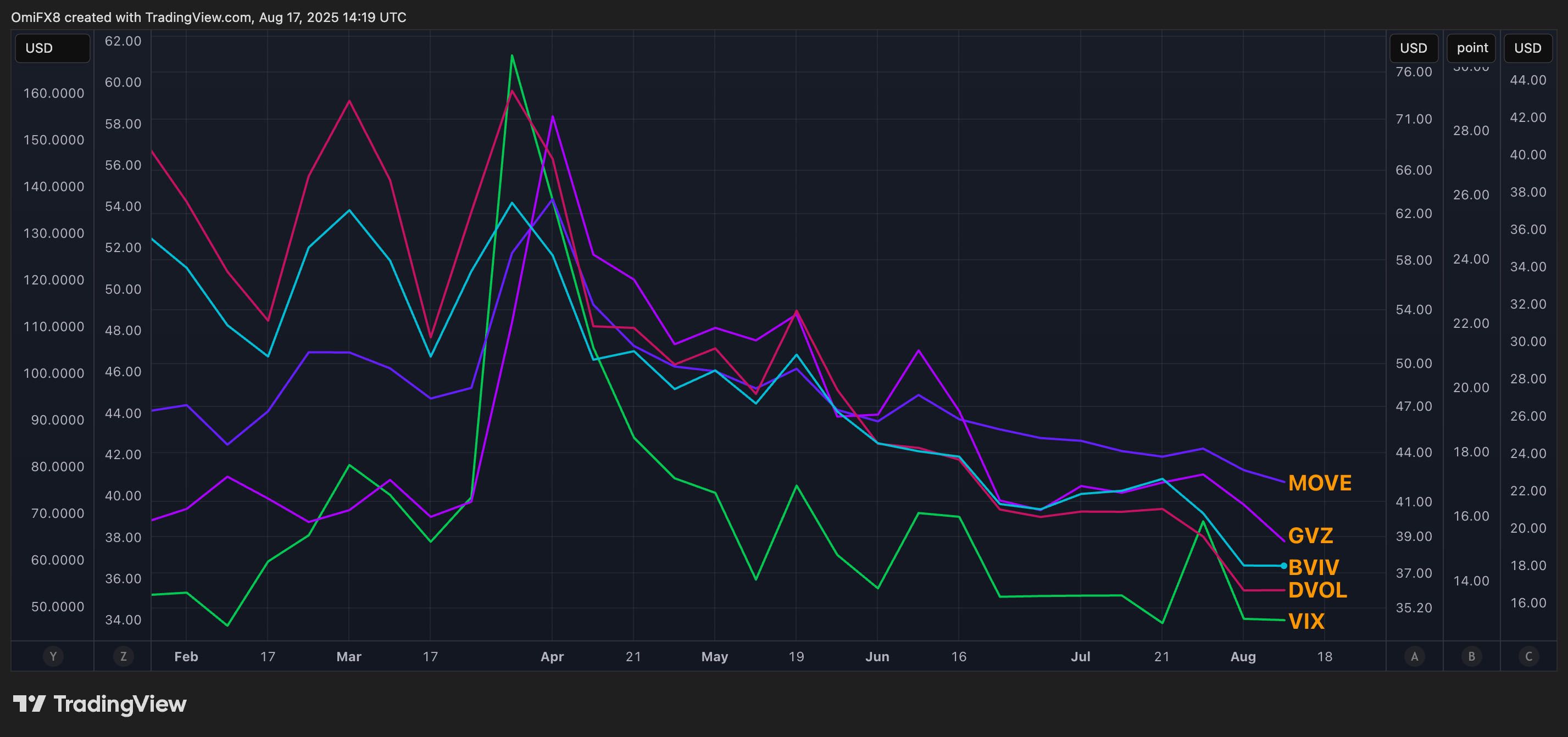Markets, Macro, Powell, Interest Rates, market analysis, News The decline in volatility across asset classes likely reflects expectations for easy monetary policy and economic stability; however, some analysts are warning of potential downside risks.
A pervasive calm has taken hold of asset classes as traders look forward to Federal Reserve (Fed) Chairman Jerome Powell’s speech at the annual Jackson Hole Symposium, scheduled for Aug. 21-23.
Bitcoin’s (BTC) 30-day implied volatility, as measured by Volmex’s BVIV and Deribit’s DVOL index, has declined sharply in recent months, hovering near two-year lows of around 36% last week, according to TradingView data.
Similarly, the CME Gold Volatility Index (GVZ), which estimates the expected 30-day volatility of returns for the SPDR Gold Shares ETF (GLD), has more than halved over the past four months, dropping to 15.22%—its lowest level since January.

The MOVE index, which tracks the 30-day implied volatility of Treasury notes, has also declined in recent months, reaching a 3.5-year low of 76%.
Meanwhile, the VIX, widely regarded as Wall Street’s “fear gauge,” fell below 14% last week, down substantially from its early April highs near 45%. A similar vol compression is seen in FX majors such as the EUR/USD.
Rates are ‘still high’
The pronounced slide in volatility across major assets comes as central banks, particularly the Fed, are expected to deliver rate cuts from restrictive territory, rather than amid a crisis.
“Most major economies are not easing from ultra-low or emergency levels like we saw after the financial crisis or during COVID. They’re cutting from restrictive territory, meaning rates are still high enough to slow growth, and in many cases, real rates, adjusted for inflation, are still positive. That’s a big shift from the last easing cycles, and it changes how the next phase plays out,” pseudonymous observer Endgame Macro noted on X, explaining the bull run in all assets, including cryptocurrencies and stock markets.
According to the CME’s FedWatch tool, the Fed is expected to cut rates by 25 basis points in September, resuming the easing cycle after an eight-month pause. Investment banking giant JPMorgan expects the benchmark borrowing cost to drop to 3.25%-3.5% by the end of the first quarter of 2026, a 100-basis-point decrease from the current 4.25%.
Per some observers, Powell could lay the groundwork for fresh easing during this Jackson Hole speech.
“The path to rate cuts may be uneven, as we have seen over the last two years, where markets have been eager for rate cuts and sometimes disappointed that the Fed has not delivered them. But we believe the direction of travel for rates is likely to remain lower,” Angelo Kourkafas, a senior global investment strategist at Edward Jones, said in a blog post on Friday.
“With inflation treading water and labour-market strains becoming more pronounced, the balance of risks may soon tip toward action. Chair Powell’s upcoming remarks at Jackson Hole could validate the now-high expectations that, after a seven-month pause, rate cuts will resume in September,” Jones added.
In other words, the decline in volatility across asset classes likely reflects expectations for easy monetary policy and economic stability.
Markets too complacent?
However, contrarians may view it as a sign that markets are too complacent, as President Donald Trump’s trade tariffs threaten to weigh on economic growth, and the latest data points to sticky inflation.
Just take a look at the price levels for most assets, including BTC and gold: They are all at record highs.
Prosper Trading Academy’s Scott Bauer argued last week during an interview with Schwab Network that volatility is too low following the recent round of economic data, with more uncertainty on the horizon.
The argument for market complacency gains credence when viewed against the backdrop of bond markets, where corporate bond spreads hit their lowest since 2007. That prompted analysts at Goldman Sachs to warn clients against complacency and take hedges.
“There are enough sources of downside risks to warrant keeping some hedges on in portfolios,” Goldman strategists led by Lotfi Karoui wrote in a note dated July 31, according to Bloomberg.
“Growth could surprise further to the downside,” dis-inflationary pressures could fade or renewed concerns over Fed independence may fuel a sharp selloff in long-dated yields.
In any case, volatility is mean-reverting, meaning periods of low volatility typically set the stage for a return to more turbulent conditions.
CoinDesk: Bitcoin, Ethereum, Crypto News and Price Data Read More
